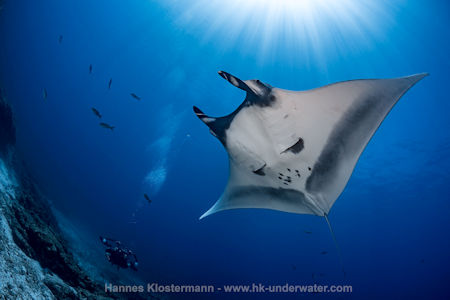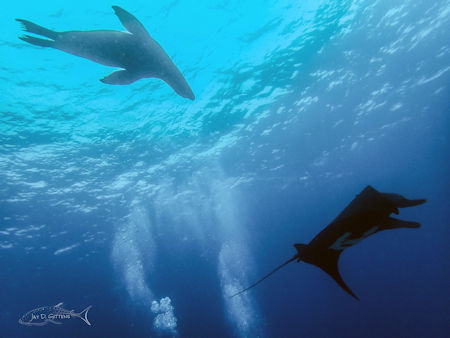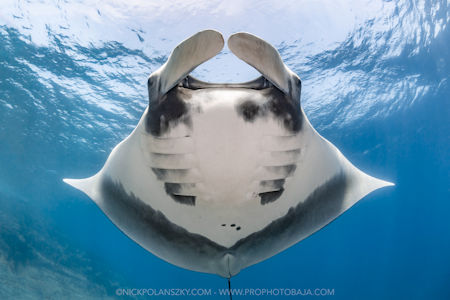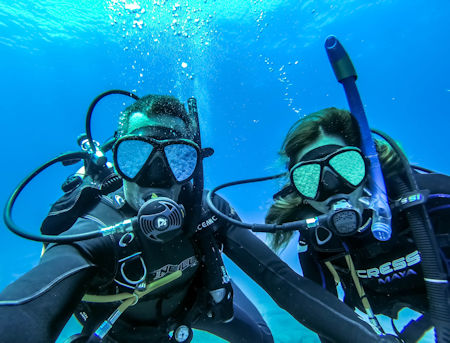 |  |

I remember the excitement of the moment very well. Scrolling through my Facebook newsfeed, I stumble across the post of an acquaintance who stated that several oceanic giant manta rays (Mobula birostris) had been encountered at a rocky islet called “La Reina” which lies just off the northern-tip of Isla Cerralvo, which, itself, lies off the coast of La Paz. Although there had been several infrequent sightings of these mantas over the years, there had not been a report of an actual aggregation, which, in biological terms, is defined as when two or more individuals of the same species come together for a common cause such as feeding or breeding. But 15 years later, here they are once again and the big question on our minds of course is “why?”
I’d previously learnt that these oceanic giants had once graced divers and snorkelers visiting the area but no one could reliably explain why they had all but vanished. Some would blame their sudden disappearance on the fisheries whilst others put it down to displacement caused by either predation pressure or the naturally changing dynamics of the surrounding sea. Animals instinctively seek the best conditions in which to survive and thrive. It could just be that for those 15 years of absence the grass was greener on the other side of the fence, so to speak.
The oceanic giant manta - Mobula birostris
The oceanic giant manta ray is the largest species of ray on the planet, reaching sizes of up to 7 metres / 23 feet across. They have a circumglobal distribution, typically associated with tropical and subtropical waters but are also periodically encountered in temperate waters. These animals are partial filter-feeders, straining plankton-rich surface water for around 30% of their food. The remaining 70% of their diet is captured in the deep ocean and includes small fish.

The oceanic giant manta is listed on The International Union for Conservation of Nature’s (IUCN) Redlist of Threatened Species as “vulnerable” to extinction due to a drastic decrease in its global population over the last two decades resulting largely from overfishing.
Not too unlike our own fingerprints, oceanic giant mantas have a pattern on their undersides that is unique to each individual, allowing scientists and citizen scientists to identify them through the examination of suitable photographs. This method of photo-identification is used to answer questions about population size and dynamics, seasonal abundance, time of site residency, site fidelity and even foraging or migratory movements of individuals.
In 1999, marine biologist Pablo Ahuja founded Manta Mexico, a community project whose purpose was to learn more about the mantas. Working with elasmobranch researcher Dr. Felipe Galván of the research centre CICIMAR here in La Paz, as well as with several service providers, Pablo began to examine the behaviour of the animals in an attempt to determine why La Reina was so important to the species. “All of the individuals were and still are juveniles instantly ruling out mating”, Pablo explains, “…. and the behavioural study showed no evidence that they were there to feed. Often mantas would be observed being cleaned by various cleaner fish species but this didn’t seem to be the primary reason for their occurrence.”
What is very interesting is that the mantas typical behaviour is to circle the islet very slowly throughout the daytime as if they are there to rest, perhaps using La Reina as an easy location to navigate around.
In 2001, Pablo extended the study to include photo-identification of individuals so that the population size could be estimated. 52 individual mantas were identified over the years 2001 and 2002 with an exact 50/50 split of males and females in the final analysis.
In the year 2003, the mantas did not return.
The giants are back!

Over 2003 and 2004, no mantas had been sighted at La Reina and despite the site being an excellent dive destination, even in the absence of mantas, operators stopped running trips there due to the distance and they favoured the Espiritu Santo Archipelago instead.
Last year two giant mantas were photo-identified at La Reina but this wasn’t enough to declare their return. Then in June of this year it’s almost as if someone flicked a switch and they are back. The historic average seasonal abundance is 26 individuals. This year 15 individuals have been identified so far, around 40% less than back in 2001 and 2002. Could this be in-line with their global population decline expressed in local or regional terms?
If history is anything to go by, it is expected that the mantas will depart around mid-November and we are crossing our fingers now that the mantas return to La Reina again next year, giving us the opportunity to further enjoy, study and understand them.
La Reina and the mantas under threat?
A real issue that La Reina and its mantas are facing is that La Reina is completely unprotected by any legal legislation despite the fact that the mantas themselves are. This means that there is no management plan for interacting with the mantas in the area as well as no official codes of conduct. Manta Mexico and several service providers have taken it upon themselves to discuss, agree upon and publish the best possible practises concerning interactions with the species at La Reina to secure the sustainability of the industry.
Collaboration between Manta Mexico, WWF, Eco, Pelagic Life and Tiburón Ballena México, has resulted in two individual mantas being fitted with a satellite tag device and four individuals fitted with acoustic tags. Pablo explains, “The satellite technology can be useful in determining where the mantas go when they leave La Reina whilst the acoustic tags, used in conjunction with acoustic receivers, can tell us when they are present at this site. With regards to the satellite tags, these are due to automatically detach from the individuals in December.”

The data held within the tags will be transmitted to the Argos satellite system before being downloaded and analysed by researchers. It is hoped that the data will reveal some secrets about the mantas migratory pathways, with the ultimate goal of securing official protection for these vulnerable creatures throughout their range.
A guide to interacting with mantas
While we wait in anticipation for the protection of La Reina and the implementation of a sound management plan, it is the responsibly of the tour operators together with their captains and guides to ensure that they offer responsible interactions with the mantas. Whilst we rely on scientific study and general observations in the field to better direct the protection of the area and the species, a lot of how we should work around the mantas comes from our experience of working with other threatened species such as whale sharks, and also from working in nearby protected areas such as Balandra Bay and the Espiritu Santo Archipelago.
As well as the onus falling on the operators and their representatives, wildlife tourism participants also have a crucial role to play in the sustainability of any wildlife tourism industry. For starters, visitors should research the internet in advance, using websites such as TripAdvisor and other reviews such as those on social media platforms to aid in choosing a reputable operator. Showing up on the dock, as an example, with no reservation and no idea whose boat you are boarding in order to interact with a threatened species would be nothing short of irresponsible. Participants are urged to listen carefully to their guide’s briefing, honouring all guidelines and asking questions if they are uncertain about anything. Guests should speak up if they feel that something isn’t quite right. Did the guide give you a briefing? If not, ask them to. Do you know and understand the codes of conduct regarding interacting with the species? This is crucial information. Wildlife tourism participants are a powerful tool in aiding sustainability.
Community agreed codes of conduct
Below are the main best practises that have been agreed between the service providers and biologists/conservationists of La Paz.
If these codes of conduct are harnessed by all visitors and their respective hosts, then we can be reasonably confident that the industry is sustainable. Best practise suggestions are expected to evolve over time as we learn more about the mantas.
The oceanic giant mantas are a joy to share space with and I recommend to any ocean-lover that visits La Paz to go and learn something about these incredible animals. Just do it responsibly.

For more information about Manta Mexico, you can connect with them through their Facebook page.
You can view Baja Wildlife Diaries for more information about my responsible trips to dive or snorkel with the giant mantas at La Reina.
Contact:
+52 1 (612) 197 5824
Website
bajawildlifediaries(at)gmail.com

Fair price. Webpage could be improved.

In a somewhat unusual accident, BajaBound (Ms. Garcia/Mrs. Lopez) and HDI (Ms. Villalpando) were...